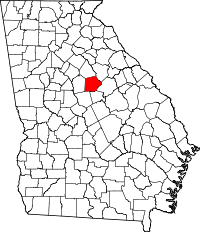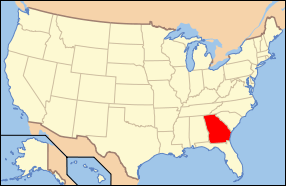Putnam County, Georgia
| Putnam County, Georgia | |
|---|---|
 Putnam County courthouse in Eatonton | |
 Location in the U.S. state of Georgia | |
 Georgia's location in the U.S. | |
| Founded | December 10, 1807 |
| Named for | Israel Putnam |
| Seat | Eatonton |
| Largest city | Eatonton |
| Area | |
| • Total | 361 sq mi (935 km2) |
| • Land | 345 sq mi (894 km2) |
| • Water | 16 sq mi (41 km2), 4.4% |
| Population | |
| • (2010) | 21,218 |
| • Density | 62/sq mi (24/km²) |
| Congressional district | 10th |
| Time zone | Eastern: UTC-5/-4 |
| Website |
www |
Putnam County is a county located in the Piedmont region of the U.S. state of Georgia. As of the 2010 census, the population was 21,218.[1] The county seat is Eatonton.[2]
Since the early 21st century, the county has had a housing boom. It has proximity to Lake Oconee, a recreation site, as well as to major employment centers such as Atlanta, Athens, and Macon.
History
Putnam County is named in honor of Israel Putnam, a hero of the French and Indian War and a general in the American Revolutionary War. It was settled by European Americans after the war, as migrants moved down from the Upper South. The County was created on December 10, 1807 by an act of the Georgia General Assembly.
Following the invention of the cotton gin, which could profitably process short-staple cotton, the county was developed for cotton cultivation of that type. It thrived in the upland areas, where plantations were developed and worked by the field labor of thousands of African-American slaves. African Americans still comprise more than 40 percent of the county population, although thousands left during the Great Migration from 1920 to 1960. The county population dropped by more than half during this period following mechanization of agriculture and as rural workers moved into cities.
In the 21st century, dairy farming is more important to Putnam County than cotton. It annually holds the nationally known Dairy Festival.
Geography
According to the U.S. Census Bureau, the county has a total area of 361 square miles (930 km2), of which 345 square miles (890 km2) is land and 16 square miles (41 km2) (4.4%) is water.[3] The entirety of Putnam County is located in the Upper Oconee River sub-basin of the Altamaha River basin.[4]
Major highways
Adjacent counties
- Morgan County (north)
- Greene County (northeast)
- Hancock County (east)
- Baldwin County (southeast)
- Jones County (southwest)
- Jasper County (west)
National protected area
- Oconee National Forest (part)
Demographics
| Historical population | |||
|---|---|---|---|
| Census | Pop. | %± | |
| 1810 | 10,029 | — | |
| 1820 | 15,475 | 54.3% | |
| 1830 | 13,261 | −14.3% | |
| 1840 | 10,260 | −22.6% | |
| 1850 | 10,794 | 5.2% | |
| 1860 | 10,125 | −6.2% | |
| 1870 | 10,461 | 3.3% | |
| 1880 | 14,539 | 39.0% | |
| 1890 | 14,842 | 2.1% | |
| 1900 | 13,436 | −9.5% | |
| 1910 | 13,876 | 3.3% | |
| 1920 | 15,151 | 9.2% | |
| 1930 | 8,367 | −44.8% | |
| 1940 | 8,514 | 1.8% | |
| 1950 | 7,731 | −9.2% | |
| 1960 | 7,798 | 0.9% | |
| 1970 | 8,394 | 7.6% | |
| 1980 | 10,295 | 22.6% | |
| 1990 | 14,137 | 37.3% | |
| 2000 | 18,812 | 33.1% | |
| 2010 | 21,218 | 12.8% | |
| Est. 2015 | 21,353 | [5] | 0.6% |
| U.S. Decennial Census[6] 1790-1960[7] 1900-1990[8] 1990-2000[9] 2010-2013[1] | |||
2000 census
As of the census[10] of 2000, there were 18,812 people, 7,402 households, and 5,477 families residing in the county. The population density was 55 people per square mile (21/km²). There were 10,319 housing units at an average density of 30 per square mile (12/km²). The racial makeup of the county was 51.45% White, 41.90% Black or African American, 0.20% Native American, 0.66% Asian, 0.04% Pacific Islander, 0.82% from other races, and 0.92% from two or more races. 2.16% of the population were Hispanic or Latino of any race.
There were 7,402 households out of which 28.50% had children under the age of 18 living with them, 56.80% were married couples living together, 12.80% had a female householder with no husband present, and 26.00% were non-families. 22.00% of all households were made up of individuals and 7.80% had someone living alone who was 65 years of age or older. The average household size was 2.50 and the average family size was 2.90.
In the county the population was spread out with 23.20% under the age of 18, 7.70% from 18 to 24, 27.00% from 25 to 44, 28.00% from 45 to 64, and 14.10% who were 65 years of age or older. The median age was 40 years. For every 100 females there were 97.00 males. For every 100 females age 18 and over, there were 96.40 males.
The median income for a household in the county was $36,956, and the median income for a family was $43,262. Males had a median income of $30,900 versus $21,823 for females. The per capita income for the county was $20,161. About 10.50% of families and 14.60% of the population were below the poverty line, including 20.80% of those under age 18 and 9.80% of those age 65 or over.
2010 census
As of the 2010 United States Census, there were 21,218 people, 8,601 households, and 6,075 families residing in the county.[11] The population density was 61.6 inhabitants per square mile (23.8/km2). There were 12,804 housing units at an average density of 37.2 per square mile (14.4/km2).[12] The racial makeup of the county was 67.9% white, 26.0% black or African American, 0.5% Asian, 0.2% American Indian, 0.1% Pacific islander, 4.1% from other races, and 1.2% from two or more races. Those of Hispanic or Latino origin made up 6.3% of the population.[11] In terms of ancestry, 27.2% were American, 26.0% African, 10.7% were Irish, 9.9% were English, and 5.9% were German.[13]
Of the 8,601 households, 29.0% had children under the age of 18 living with them, 51.8% were married couples living together, 14.2% had a female householder with no husband present, 29.4% were non-families, and 24.7% of all households were made up of individuals. The average household size was 2.45 and the average family size was 2.88. The median age was 43.5 years.[11]
The median income for a household in the county was $41,529 and the median income for a family was $49,814. Males had a median income of $31,915 versus $30,857 for females. The per capita income for the county was $25,576. About 9.3% of families and 12.3% of the population were below the poverty line, including 17.0% of those under age 18 and 12.0% of those age 65 or over.[14]
Communities
Education
The Putnam County Charter School System serves the community.
See also
- National Register of Historic Places listings in Putnam County, Georgia
- Tama-Re
- Rock Eagle Effigy Mound
- Rock Hawk Effigy Mound
References
- 1 2 "State & County QuickFacts". United States Census Bureau. Retrieved February 18, 2014.
- ↑ "Find a County". National Association of Counties. Retrieved 2011-06-07.
- ↑ "US Gazetteer files: 2010, 2000, and 1990". United States Census Bureau. 2011-02-12. Retrieved 2011-04-23.
- ↑ "Georgia Soil and Water Conservation Commission Interactive Mapping Experience". Georgia Soil and Water Conservation Commission. Retrieved 2015-11-20.
- ↑ "County Totals Dataset: Population, Population Change and Estimated Components of Population Change: April 1, 2010 to July 1, 2015". Retrieved July 2, 2016.
- ↑ "U.S. Decennial Census". United States Census Bureau. Retrieved June 25, 2014.
- ↑ "Historical Census Browser". University of Virginia Library. Retrieved June 25, 2014.
- ↑ "Population of Counties by Decennial Census: 1900 to 1990". United States Census Bureau. Retrieved June 25, 2014.
- ↑ "Census 2000 PHC-T-4. Ranking Tables for Counties: 1990 and 2000" (PDF). United States Census Bureau. Retrieved June 25, 2014.
- ↑ "American FactFinder". United States Census Bureau. Retrieved 2008-01-31.
- 1 2 3 "DP-1 Profile of General Population and Housing Characteristics: 2010 Demographic Profile Data". United States Census Bureau. Retrieved 2015-12-30.
- ↑ "Population, Housing Units, Area, and Density: 2010 - County". United States Census Bureau. Retrieved 2015-12-30.
- ↑ "DP02 SELECTED SOCIAL CHARACTERISTICS IN THE UNITED STATES – 2006-2010 American Community Survey 5-Year Estimates". United States Census Bureau. Retrieved 2015-12-30.
- ↑ "DP03 SELECTED ECONOMIC CHARACTERISTICS – 2006-2010 American Community Survey 5-Year Estimates". United States Census Bureau. Retrieved 2015-12-30.
External links
 |
Morgan County | Greene County |  | |
| Jasper County | |
Hancock County | ||
| ||||
| | ||||
| Jones County | Baldwin County |
Coordinates: 33°19′N 83°22′W / 33.32°N 83.37°W
